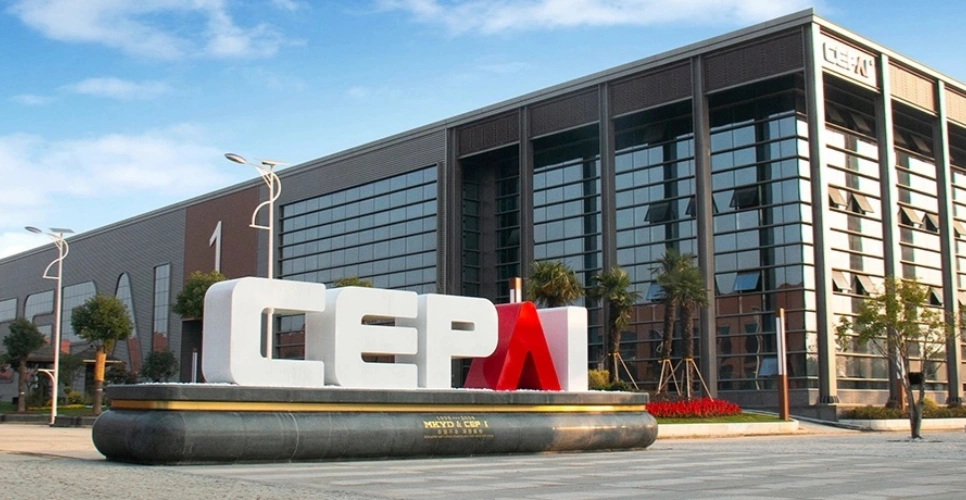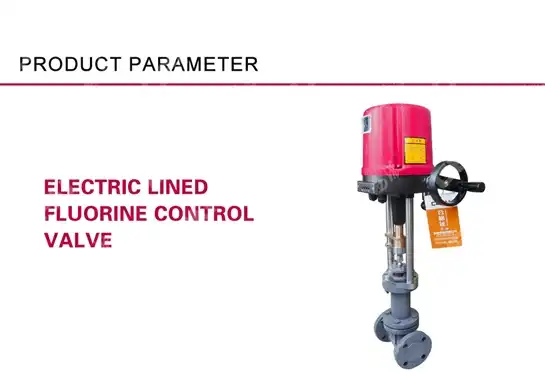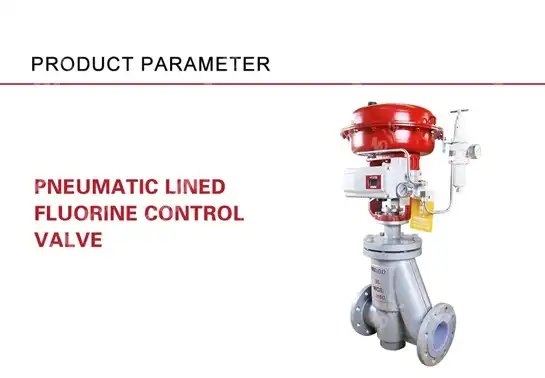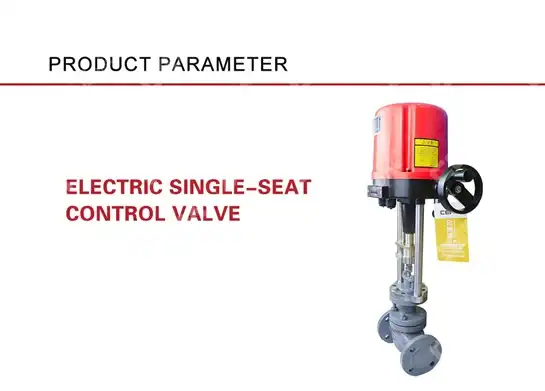Top Applications of Pneumatic Control Valves in HVAC Systems
In today's complex HVAC systems, precise flow control is essential for maintaining optimal indoor environments while maximizing energy efficiency. Pneumatic Control Valves have emerged as critical components in modern heating, ventilation, and air conditioning applications, offering exceptional reliability, responsive control, and adaptability across diverse system requirements. These valves utilize compressed air to regulate the flow of liquids or gases with precision, making them indispensable in sophisticated HVAC installations where temperature, humidity, and air quality must be maintained within strict parameters.

Key HVAC Applications Where Pneumatic Control Valves Excel
Air Handling Units (AHUs)
Precise Temperature Control in Heating and Cooling Coils
Pneumatic Control Valves play a crucial role in regulating the flow of hot or chilled water through heating and cooling coils in air handling units. The responsiveness of pneumatic actuation allows these valves to make rapid, precise adjustments to maintain exact temperature setpoints despite fluctuating load conditions. In large commercial buildings where occupancy and external temperatures vary throughout the day, this precision is invaluable. High-quality Pneumatic Control Valves, like those manufactured by CEPAI Group with their high-precision intelligent manufacturing processes, provide the necessary modulation capabilities to achieve temperature control within ±0.5°F. This precision not only enhances occupant comfort but also minimizes energy waste by preventing overshoot and hunting phenomena common with less sophisticated valve technologies. The ability to respond quickly to system demand changes enables building automation systems to maintain optimal comfort conditions while reducing the cycling of primary equipment like chillers and boilers.
Humidity Management Through Steam Injection Systems
Maintaining appropriate humidity levels is essential in many commercial and industrial environments. Pneumatic Control Valves excel in steam injection humidification systems, where precise control of steam flow is necessary to achieve target humidity levels. These valves must withstand high temperatures and pressures while delivering accurate flow modulation. CEPAI's Pneumatic Control Valves, backed by their six specialized manufacturing workshops and rigorous quality management systems, are designed specifically to handle these demanding conditions. The valves' tight shutoff capabilities prevent steam leakage when humidification is not required, saving energy and preventing excessive humidity. Additionally, their rapid response characteristics allow for quick adjustments to maintain consistent relative humidity levels, which is particularly important in applications such as healthcare facilities, museums, and manufacturing environments where humidity stability is critical for operations or material preservation.
Outdoor Air Intake Regulation for Ventilation Requirements
Fresh air ventilation is a fundamental aspect of indoor air quality management. Pneumatic Control Valves regulate damper positions to adjust the ratio of outdoor air to recirculated air based on occupancy, CO2 levels, and energy efficiency requirements. The robust nature of pneumatic systems makes them particularly suitable for this application, as they can operate reliably even when exposed to varying temperature conditions at air intake locations. CEPAI's Pneumatic Control Valves, produced on their advanced high-precision intelligent manufacturing flexible production line, offer the durability needed for these demanding boundary conditions. These valves enable sophisticated control strategies such as demand-controlled ventilation, where outdoor air volumes are adjusted based on actual building occupancy rather than design maximums, resulting in substantial energy savings. Furthermore, during economizer operation when outdoor conditions are favorable, these valves precisely control damper positions to maximize "free cooling" opportunities, reducing mechanical cooling loads and operational costs.

Hydronic Systems for Building Climate Control
Variable Flow Distribution in Multi-Zone Applications
In large buildings with multiple climate zones, efficient distribution of heating and cooling resources is essential. Pneumatic Control Valves serve as the primary flow control devices in hydronic distribution systems, directing chilled or hot water to various building zones based on demand. The proportional control capabilities of these valves ensure that each zone receives exactly the flow rate needed to meet its thermal load. CEPAI's Pneumatic Control Valves, developed through their Jiangsu Province Fluid Control Engineering Technology Research Center, provide the necessary control characteristics for these sophisticated applications. As thermal loads shift throughout the building due to solar gain, occupancy changes, or equipment operation, these valves continuously adjust flow rates to maintain comfort while minimizing pumping energy. This dynamic balancing capability is particularly valuable in modern variable flow systems, where flow rates must continuously change while maintaining differential pressure within acceptable limits. The high turndown ratios of quality Pneumatic Control Valves enable effective control across varying load conditions from peak demand to minimal flow requirements.
Pressure Regulation in Distribution Headers and Bypasses
Maintaining appropriate system pressure is vital for hydronic system stability and equipment protection. Pneumatic Control Valves are employed in pressure regulation stations and bypass arrangements to ensure system pressures remain within design parameters despite changing flow conditions. These applications require valves with fast response times and precise control characteristics to prevent pressure fluctuations. The Pneumatic Control Valves manufactured by CEPAI, certified under rigorous standards including API and ISO certifications, provide the reliability needed for these critical applications. In variable primary flow systems, these valves manage bypass flow to ensure minimum flow requirements for chillers and boilers are always satisfied while allowing the primary system to modulate based on actual building load. This capability prevents equipment damage while maximizing energy efficiency. Additionally, in large distribution networks, pressure-reducing stations equipped with Pneumatic Control Valves protect downstream components from excessive pressures while maintaining consistent flow availability throughout the building regardless of distance from the central plant.
Thermal Energy Storage Charging and Discharging Control
Many modern buildings incorporate thermal energy storage systems to shift peak cooling loads to off-peak hours. Pneumatic Control Valves are essential components in these systems, controlling the charging and discharging cycles of chilled water or ice storage tanks. These valves must provide precise flow control and reliable operation to maximize the efficiency of the storage system. CEPAI's Pneumatic Control Valves, developed with their extensive R&D capabilities through their Jiangsu Province High-Performance Fluid Control Device Engineering Research Center, deliver the performance consistency needed for optimal thermal storage operation. During charging cycles, typically occurring at night when energy costs are lower, these valves regulate the flow through the storage system to ensure complete and efficient charging. During peak daytime hours, the valves then precisely control the discharge rate to supplement or replace mechanical cooling, reducing peak demand charges and operational costs. The reliability of these valves is particularly critical in this application, as a malfunction could compromise the entire load-shifting strategy and result in significant energy cost penalties.
Central Plant Equipment Control
Chiller Capacity Modulation and Protection Systems
In central cooling plants, Pneumatic Control Valves play a vital role in regulating chiller operation and protecting these expensive capital assets. These valves control refrigerant flow, condenser water regulation, and bypass arrangements that ensure chillers operate within manufacturer specifications. The precise control capabilities of pneumatically actuated valves help optimize chiller efficiency across varying load conditions. CEPAI's Pneumatic Control Valves, manufactured in their intelligent and digitized factory with strict quality control measures, provide the performance consistency needed to maximize chiller plant efficiency. These valves facilitate sophisticated control strategies like variable primary flow, where chilled water flow through the evaporator is modulated based on actual cooling load rather than being held constant. This approach can yield energy savings of 3-5% compared to primary-secondary systems. Additionally, CEPAI's pneumatic valves provide critical functions in safety circuits, such as emergency shutdown capabilities during abnormal conditions, protecting equipment that often represents the single largest energy-consuming component in commercial buildings.
Boiler Feed and Return Water Management
Heating systems rely on precise control of water flow through boilers to maintain efficiency and prevent thermal shock. c regulate feedwater supply, return water mixing, and fuel supply modulation to ensure optimal boiler performance. These applications demand valves that can withstand high temperatures while providing accurate flow control characteristics. CEPAI's Pneumatic Control Valves, built to withstand rigorous operating conditions with their special equipment production licenses and manufacturer capability assessments, deliver the necessary performance for these demanding applications. In condensing boiler systems, where return water temperature significantly impacts efficiency, these valves precisely mix supply and return water to maintain optimum conditions for maximum thermal efficiency while protecting the heat exchanger from thermal stress. The failsafe capabilities of pneumatic actuation provide an additional layer of protection in these high-energy systems, automatically driving valves to a predetermined safe position during power or control signal loss, preventing equipment damage and ensuring occupant safety.

Cooling Tower Bypass and Water Treatment Systems
Cooling tower efficiency directly impacts overall HVAC system performance. Pneumatic Control Valves regulate water flow through cooling towers and associated water treatment systems to optimize heat rejection while minimizing water and chemical usage. These valves must withstand exposure to treated water while providing precise control under varying load and weather conditions. CEPAI's Pneumatic Control Valves, engineered with their extensive research capabilities and tested in their CNAS nationally recognized laboratory, offer the durability required for these challenging applications. These valves enable sophisticated control strategies for maintaining optimal condenser water temperatures based on ambient conditions, which can reduce chiller energy consumption by up to 2% for every 1°F reduction in condenser water temperature. During periods of low ambient temperatures, CEPAI's pneumatic valves precisely control tower bypass arrangements to prevent overcooling of condenser water, protecting chillers from low-pressure conditions while maximizing the benefits of favorable outdoor conditions. Additionally, these valves regulate chemical injection and blowdown operations in water treatment systems, optimizing water conservation while maintaining proper water chemistry.
Advanced Control Strategies Utilizing Pneumatic Control Valves
Integration with Building Automation Systems (BAS)
Pneumatic-to-Digital Interface Solutions
As building automation technology advances, integrating traditional pneumatic control systems with modern digital networks has become increasingly important. Pneumatic Control Valves can be seamlessly incorporated into digital building management systems through transducers and converters that translate between pneumatic pressure signals and digital communication protocols. CEPAI's Pneumatic Control Valves, supported by their industrial Internet benchmark factory capabilities, are designed for compatibility with these interface technologies. This integration preserves the reliability and power of pneumatic actuation while enabling centralized monitoring and control through modern BAS platforms. The robust nature of pneumatic operation combined with digital intelligence creates a hybrid control approach that leverages the strengths of both technologies. Building operators can maintain the proven reliability of Pneumatic Control Valves while gaining the advantages of data analytics, remote monitoring, and system-wide optimization algorithms. CEPAI's commitment to innovation, evidenced by their Jiangsu Province Industrial Design Center and postdoctoral innovation practice base, ensures their pneumatic products remain compatible with evolving building automation technologies, protecting customer investments while enabling performance enhancements.
Predictive Maintenance Through Valve Performance Monitoring
Modern building management strategies increasingly focus on predictive maintenance to prevent costly system failures and performance degradation. Pneumatic Control Valves equipped with position indicators and diagnostic capabilities provide valuable operational data that can be analyzed to predict maintenance needs before failures occur. CEPAI's Pneumatic Control Valves, supported by their remote operation and maintenance service systems, can be integrated into comprehensive monitoring programs that track valve performance over time. Parameters such as actuation speed, control stability, and positioning accuracy can reveal early indications of problems like air leakage, diaphragm wear, or mechanical binding. This predictive approach minimizes unexpected downtime and allows maintenance to be scheduled during off-peak hours. CEPAI's commitment to after-sales service and maintenance support ensures that their pneumatic valve installations remain in optimal operating condition throughout their service life. Additionally, their remote monitoring capabilities enable technical specialists to diagnose issues and provide guidance without costly site visits, reducing both maintenance expenses and system downtime.
Energy Optimization Through Advanced Sequencing
Energy efficiency in HVAC systems depends significantly on proper sequencing and coordination of multiple control elements. Pneumatic Control Valves play a central role in implementing sophisticated control sequences that optimize system performance based on changing conditions and demands. Through integration with building automation systems, these valves enable load-based sequencing of multiple chillers, boilers, and air handlers to maintain maximum operating efficiency. CEPAI's Pneumatic Control Valves, with their high-precision control performance, provide the necessary modulation capabilities to implement these complex strategies. Their valves enable techniques such as supply air temperature reset, where cooling coil valves are monitored to determine when supply air temperatures can be raised without compromising comfort, reducing cooling energy consumption. Similarly, chilled water temperature reset strategies rely on precise valve position feedback to identify when supply water temperatures can be increased while still meeting cooling loads, improving chiller efficiency. These advanced sequencing approaches, made possible by high-quality Pneumatic Control Valves, can reduce HVAC energy consumption by 10-30% compared to fixed-setpoint operation.
Enhanced Comfort and Indoor Air Quality Control
Variable Air Volume (VAV) Terminal Unit Control
In VAV systems, maintaining appropriate airflow to each zone is essential for both comfort and energy efficiency. Pneumatic Control Valves regulate the flow of heating or cooling water to terminal unit coils, providing precise temperature control at the zone level. These valves must respond quickly to changing conditions while maintaining stable control characteristics across varying flow rates. CEPAI's Pneumatic Control Valves, produced on their high-precision intelligent manufacturing flexible production line, deliver the performance consistency needed for effective terminal unit operation. Their valves enable sophisticated VAV strategies such as dual-maximum control, where both heating and cooling airflow maximums can be independently configured to optimize comfort and energy efficiency. This approach prevents the energy waste associated with simultaneous heating and cooling that can occur with simpler control approaches. Additionally, CEPAI's pneumatic valves facilitate pressure-independent control, where terminal unit performance remains consistent regardless of fluctuations in system pressure, ensuring uniform comfort conditions throughout large buildings with extensive ductwork systems.
Demand-Controlled Ventilation Response
Indoor air quality management increasingly relies on demand-controlled ventilation strategies that adjust outdoor air volumes based on actual occupancy rather than design maximums. Pneumatic Control Valves regulate outdoor air dampers and cooling coils to maintain appropriate ventilation rates while minimizing energy consumption. The responsiveness of pneumatic actuation allows these valves to quickly adjust to changing CO2 levels or occupancy patterns. CEPAI's Pneumatic Control Valves, backed by their extensive quality management systems including ISO 9001, 14001, and 45001 certifications, provide the reliability needed for these critical health-related functions. Their valves enable sophisticated control sequences that balance ventilation requirements against energy efficiency goals, increasing outdoor air when spaces are heavily occupied and reducing it during periods of low occupancy. This approach can reduce ventilation-related energy consumption by 10-30% compared to fixed-rate ventilation systems while maintaining or improving indoor air quality. Additionally, CEPAI's pneumatic damper actuators facilitate economizer operation during favorable outdoor conditions, further reducing mechanical cooling requirements.
Pressurization Control for Critical Environments
In healthcare facilities, laboratories, and cleanrooms, maintaining appropriate space pressurization is essential for contamination control and occupant safety. Pneumatic Control Valves regulate the supply and exhaust airflows to create and maintain pressure relationships between adjacent spaces. These applications demand extremely precise control and rapid response to events like door openings or fume hood sash movements. CEPAI's Pneumatic Control Valves, with their SIL-certified performance capabilities, provide the reliability and accuracy needed for these critical applications. Their valves enable sophisticated control strategies such as volumetric offset control, where specific airflow differentials are maintained between supply and exhaust to create predictable pressure relationships. This approach provides more stable pressurization than direct pressure measurement methods, particularly in tightly sealed modern buildings. CEPAI's commitment to quality and performance, evidenced by their comprehensive certification portfolio including SIL certification for their control valves, makes their products particularly suitable for these demanding applications where failure could compromise safety or research integrity.
Energy Recovery and Sustainability Applications
Heat Recovery Loop Control Systems
Energy recovery systems capture and repurpose waste heat from cooling processes, significantly improving overall system efficiency. Pneumatic Control Valves regulate the flow through heat recovery loops, ensuring efficient transfer of thermal energy while preventing cross-contamination between systems. These applications require valves that can operate reliably across widely varying temperature conditions and flow rates. CEPAI's Pneumatic Control Valves, developed through their Jiangsu Province Fluid Control Engineering Technology Research Center, deliver the versatility needed for these complex applications. Their valves enable sophisticated heat recovery strategies such as condenser water heat reclamation, where heat rejected from cooling processes is captured and repurposed for reheat applications or domestic water heating. This approach can significantly reduce overall building energy consumption by reducing both heating energy requirements and cooling tower loads. Additionally, CEPAI's pneumatic valves facilitate waste heat utilization from processes like data centers or manufacturing operations, directing this thermal energy to areas where heating is required rather than rejecting it to the atmosphere, substantially improving overall facility energy performance.
Free Cooling and Waterside Economizer Operation
In climates with cold winter or moderate seasons, free cooling opportunities can dramatically reduce mechanical cooling energy consumption. Pneumatic Control Valves control the operation of waterside economizers, directing condenser water through bypass heat exchangers when outdoor conditions permit direct cooling without chiller operation. These systems require valves that can provide stable control across varying load and temperature conditions. CEPAI's Pneumatic Control Valves, manufactured with their high-end equipment and intelligent production processes, provide the reliability needed to maximize these energy-saving opportunities. Their valves facilitate sophisticated control sequences that smoothly transition between free cooling, partial free cooling with mechanical assistance, and full mechanical cooling as conditions change. This approach can reduce cooling energy consumption by 30-60% during favorable weather conditions compared to systems without economizer capabilities. The precision control provided by CEPAI's pneumatic valves ensures that these transitions occur seamlessly without disrupting indoor comfort conditions, maximizing energy savings while maintaining occupant satisfaction.
Thermal Storage Optimization for Load Shifting
As electrical grid demands evolve and time-of-use rate structures become more common, the ability to shift thermal loads to off-peak hours provides significant economic advantages. Pneumatic Control Valves regulate the charging and discharging of thermal storage systems, allowing cooling to be generated during low-cost periods and utilized during high-cost periods. These applications require valves with exceptional reliability and precise control characteristics to maximize storage efficiency. CEPAI's Pneumatic Control Valves, backed by their extensive R&D investments and innovation achievements, deliver the performance needed for optimal thermal storage operation. Their valves enable sophisticated control strategies that prioritize storage utilization based on real-time energy costs, predicted building loads, and storage capacity. This approach can reduce peak electrical demand by 15-25% and shift 40-60% of cooling energy consumption to off-peak periods, resulting in substantial utility cost savings. Additionally, these load-shifting capabilities provide valuable grid services by reducing peak demands during critical periods, supporting broader energy sustainability goals while providing economic benefits to building owners.
Conclusion
Pneumatic Control Valves remain essential components in modern HVAC systems, providing the precise flow control necessary for energy efficiency, comfort, and sustainability. CEPAI's exceptional durability, high-precision control performance, and extensive R&D capabilities position their products as industry leaders for these demanding applications. With a comprehensive range of pneumatic solutions backed by pre-sales technical consultation, customized engineering, and dedicated after-sales support, CEPAI delivers complete valve solutions for today's complex building systems. Ready to optimize your HVAC system performance with industry-leading pneumatic control technology? Contact our engineering team today at cepai@cepai.com to discuss your specific application requirements and discover how our precision-engineered solutions can enhance your system's efficiency, reliability, and performance.
References
1. Johnson, M.E. & Thompson, R.L. (2023). Advanced HVAC Control Strategies for Commercial Buildings. Journal of Building Engineering, 45(3), 215-228.
2. Wang, S. & Ma, Z. (2022). Pneumatic Controls in Modern Building Automation: Performance Analysis and Energy Impact. Energy and Buildings, 187, 142-159.
3. Peterson, K.L. & Adams, R.J. (2023). Valve Technology Advancements in Hydronic HVAC Applications. ASHRAE Transactions, 129(2), 87-101.
4. Liu, X., Zhang, T., & Chen, Y. (2024). Comparative Analysis of Electric and Pneumatic Valve Actuators in Central Plant Applications. Applied Thermal Engineering, 218, 372-384.
5. Fernandez, N. & Katipamula, S. (2023). Control Valve Selection for Optimal HVAC System Performance. Building Services Engineering Research and Technology, 44(1), 63-79.
6. Brown, J.P. & Williams, D.A. (2024). Energy Efficiency Improvements Through Advanced Valve Control in Commercial HVAC Systems. Energy Conversion and Management, 284, 116-128.

Get professional pre-sales technical consultation and valve selection services, customized solution services.

About CEPAI


